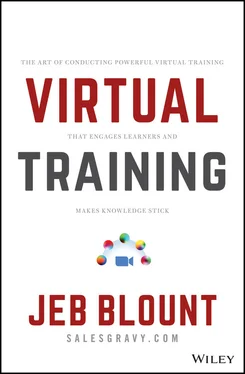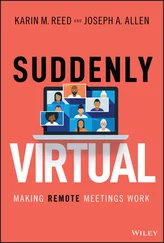Before diving in, I suggest taking time to reflect on your past experience with virtual training, the state of your current situation, and your goals and aspirations for delivering virtual training in the future.
1 What past experiences with virtual training—good and bad—stand out in your mind?
2 What do you feel will be the biggest challenges to getting your leaders, learners, customers, or organization to adopt and accept virtual instructor-led training?
3 What are the best opportunities to add VILTs/which courses in your catalog will be easiest to convert to VILT?
4 How do you feel the overall learning experience of the current VILTs you or your organization deliver measure up?
5 What goals do you have for virtual training in the future (for yourself and your organization)?
Notes:
1
PART II Mission and Mindset
The way to get through anything mentally painful is to take it a little at a time. The mind can't handle dealing with a massive iceberg of pain in front of it, but it can deal with short nuggets that will come to an end.
—Joe De Sena, founder and CEO of Spartan obstacle races
6 Mission and Mindset for a Legendary Virtual Learning Experience
Let's keep this real. As trainers, we may be stars in the classroom, but the limelight stops there. When the economy dips, we are the first to go. When organizations separate essential and nonessential workers, trainers are almost always on the nonessential list.
Despite our high profile, trainers rarely win trophies or receive accolades for our part in an organization's success. On corporate org charts, we're often invisible. This is our lot in life. Trainers know that our work matters, but to most executives and leaders, we are expendable.
It is also true that our jobs can be repetitive and, at times, boring. We teach the same material, the same way, week in and week out. The only things that change are the participants, and perhaps the city and training room.
Outside of the classroom, we deal with office politics and internal bureaucracy. It can be exhausting. Your passion is practicing your craft and making an impact on earners, instead your time is often consumed with getting over roadblocks and hurdles planted by leaders who second guess you. People who couldn't teach their way out of a paper bag are quick to tell you how to do your job, and, of course, when the people you train go back into their field roles and don't do things perfectly, you get blamed for their failures. (No one ever considers whether they've received any coaching or support from their manager to give the training a chance to stick.)
In this reality, it is easy to feel unappreciated, jaded, and cynical. It's easy to lose your passion and joy for teaching, and forget why you chose this profession in the first place—to help people reach their potential. This is exactly why you must never lose sight of the mission.
Our mission as trainers is to make a positive impact by helping people learn, grow, develop, stretch, and win. This mission fuels the passion, enthusiasm, energy, and joy we feel when delivering training.
Focusing on the mission helps you block out the noise, overcome obstacles, and breeze past adversity. Mission drive pushes you to improve, learn new skills and methodologies, and adapt to new technology so that you can make an even bigger impact on your learners.
Mission drive is the passion you feel when you make a true connection with the mission. It opens you up to new possibilities for making an impact as a trainer. It pushes you to step out of your comfort zone and do hard things. Mission drive is the key to breaking through the fear of change and building the discipline to master your craft and deliver a legendary virtual learning experience.
Without mission drive, you cannot and will not be an effective instructor and educator. You won't make an impact—and you won't be happy.
You may go through the motions, but the people you teach will see right through your façade. Without mission drive, you'll treat your learners like part of a transaction, and they'll respond in kind. They'll sit there for the required amount of time so you can talk at them for the required amount of time. They'll get a certificate of completion and you'll get paid for your time—and everyone will walk away feeling empty.
You may be able to get away with going through the motions and faking your passion in a physical classroom, but you will not in a virtual classroom. Your enthusiasm, focus, and passion for teaching are under a microscope in the virtual classroom. When you are not fully engaged, there's no hiding it. Learners know when you are not into it, and they check out. In the virtual classroom, without mission drive, you will fail.
“I'm so much better in person!”
“I didn't sign up to talk to tiny boxes on a computer.”
“I just don't feel comfortable teaching over a Zoom call.”
“I'm so nervous in front of the camera.”
“I feel so much more in control when I'm in a classroom where I can see everyone and interact.”
“I'm absolutely not going to teach virtually. Never. So, forget it. Don't even bother asking!”
“I'm sorry, I just can't do it.”
“I hate virtual training! It's not my thing.”
Each of these statements came out of a real trainer's mouth when they were asked to deliver training in a virtual classroom. The last one came out of my mouth multiple times.
If you are a talented trainer who thrives in the physical classroom, I'll bet my book royalties that you've thought similar things about virtual training. I had to get over my own hang-ups and self-consciousness and force myself to step into the virtual classroom.
What made me most uncomfortable about virtual training was the lack of validation I felt. In a virtual setting, I didn't get the same type of feedback as in the physical classroom. I walked away from virtual training sessions feeling empty—as if I hadn't made an impact.
For many other trainers, the aversion to virtual training is rooted in fear. I've looked on as otherwise-competent trainers are pushed to emotional extremes when forced to deliver virtual training. They are totally overwhelmed by the software and production equipment. They're petrified of the camera and feel like a fish out of water. Sometimes, they shut down and become paralyzed.
Take a moment to consider your mission as a trainer. See the problem? These aversions to virtual training are not tied to the mission. They have nothing to do with your learners and everything to do with you. To get over your emotional hang-ups, you have to change your mindset. Instead of thinking about what you want , think about what your learners need . Instead of focusing on what you're most comfortable with, focus on how you can grow.
The strongest negative feelings about virtual training are rooted in our own insecurities. That's what happens when we make it all about ourselves instead of focusing on our learners. So, I'm going to be blunt with you and tell you the exact same thing I've told my trainers.
I get that virtual training makes you uncomfortable because I've stood in your shoes. I understand that, especially for veteran trainers who are masters of the physical classroom, you don't feel emotionally connected to your students in a virtual environment. I know exactly how that feels.
Learning how to operate complicated software and equipment isn't easy—it makes my brain hurt, too. All you want is to teach and use your God-given talent to make a positive impact. Learning new tech isn't what you signed up for.
Читать дальше












